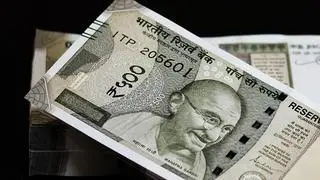By July 2013, the estimated inventory of wheat and rice with the Government of India would be more than 106 million tonnes, against 82 million tonnes this July, subject to the weather being fair (see chart) .
Reason: The Food Corporation of India (FCI) and state agencies are pro-active at the time of procurement, while not displaying the same alacrity in disposal, distribution or exports. Perhaps, there is a sheer lack of demand. Forty million tonnes of rice is stated to be official acquisition target in 2013-14. With delayed monsoon, the winter wheat crop is also expected to exceed last year’s production of 94 million tonnes. Consequently, Government wheat purchases by July 1, 2013, may surge to 40 million tonnes, against 38 million tonnes last year. As much as 50 per cent of these grains will be exposed to inhospitable storage conditions.
Approximately 14 million tonnes of old stocks of the 2010-11 and 2011-12 harvest need to be de-stocked before they deteriorate beyond use or are classified for feed or distillery purposes. Certainly, these cereals were acquired for human consumption and not for lower species.
Ballooning of stocks to 3.3 times the authorised reserves may be classified as “noble hoarding” by the Centre for delivery to intended recipients and disposal through exports. If authorities cannot distribute additional quantities purposefully, or liquidate the humongous stockpile, they may as well limit themselves to need-based purchases in 2013-14.
Wheat inflation
Three Indian PSUs commenced wheat export in August 2012 from the FCI’s latest stocks of 2012-13 on the basis of best price realisation against international tenders.
For the last three months, export values have hovered around $300-316 fob/t (Rs 16,470-17,064). Against one million tonne of tenders decided so far, approximately 500,000 tonnes has been shipped out. Since then, local prices have also risen in tandem with export shipments, though private exports are not viable from the domestic market.
Export activity is erroneously being blamed for this wheat inflation — while the real reason is restrictive releases by the FCI for private trade. The market is starved of surplus availability. It lends suspicion to the view that the FCI, despite accumulation of 43 million tonnes of wheat, is unable to inject adequate grains in the market.
Evacuate stocks
First, authorities can ensure deflation of wheat values in the market through abundant releases at discounted prices. The Government is quick in increasing MSP and building up insecure inventories. It should be equally responsive in counter- inflationary measures by deciding the price for domestic releases. Moreover, old grain stocks can be priced below corn so that domestic feed millers can also use them for livestock. Even roller flour millers will be keen to lift old grains at lower prices. This will enable mitigation of burgeoning inventory.
Second, the Government must achieve at least 10 million tonnes of wheat export before June 2013 — while the going is good. This requires shipments of one million tonnes per month. Export markets are fickle. This niche window must be exploited for better price realisation when Russia or Ukraine are out of the system.
Weather-related issues may compel Australia and Argentina to harvest a lot of feed wheat — read cheaper wheat by January or February 2012. Black Sea harvest projections will start coming in June 2013. Corn prices have reversed and are around $30/tonne lower than wheat. Bullishness of wheat is at stake.
Whatever the market conditions, disposal through PSUs will mean an average outgo of 3,00,000 tonnes per month or a maximum of 3 million tonnes by June 2013, even though all Indian ports are being used with priority berthing to avoid congestion in any single port.
The international market will also become bearish when Indian wheat stocks touch 61 million tonnes by June 2013. Though wheat export is on OGL, its implementation is under the “restrictive policy” framework. Foreign bidders can access FCI stocks at international prices, while private players are denied access to Government stocks.
FOR AUGMENTING EXPORT
To target wheat export more effectively for an incremental seven million tonnes, some suggestions are:
PSUs may be allowed to sell the “maximum” quantity for 2012-13 crop year at H1 price, over and above the “tendered” tonnage. The highest bid price will be locked for larger quantities. The future uncertainty of lower price can be partially hedged. Open interest in some tenders has been so strong that additional volumes can be contracted. The FCI and the Railways need to move more grain to ports to meet that objective.
Private trade may be allowed to access FCI stocks of old vintage — 2011-12/2010-11 (approximately 14 million tonnes). These old stocks have blocked massive resources that can be applied to future crops. Such grains can be appropriately priced and they will find willing buyers in West Asia and Far East for milling as well as feed wheat.
Non-basmati rice export is from the open market. India’s rice export has touched 10 million tonnes during the last 12 months — the highest in the world, even surpassing Thailand. Rice prices have been fairly stable locally. On the slightest inkling of any vertical movement, the FCI may promptly flush rice domestically.
The above strategy may evacuate around 15 million tonnes, both through local disposal and exports. It is yet to be seen whether National Food security Bill (NFSB) will draw down additional stocks. It may substitute PDS supplies, albeit at lower cost to consumers, with volume remaining unchanged. With a mountain of grain, there can be no apprehension over food insecurity.
(The author is a freelance commodity analyst.)








Comments
Comments have to be in English, and in full sentences. They cannot be abusive or personal. Please abide by our community guidelines for posting your comments.
We have migrated to a new commenting platform. If you are already a registered user of TheHindu Businessline and logged in, you may continue to engage with our articles. If you do not have an account please register and login to post comments. Users can access their older comments by logging into their accounts on Vuukle.